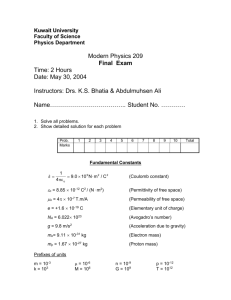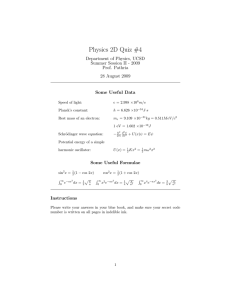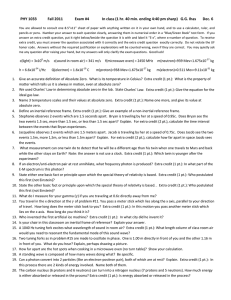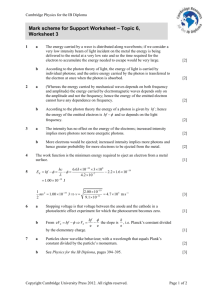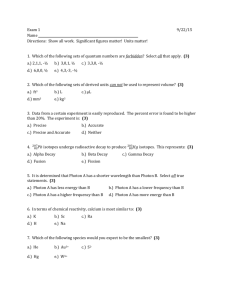Physics 2D Quiz Final Exam Department of Physics, UCSD Prof. Pathria
advertisement
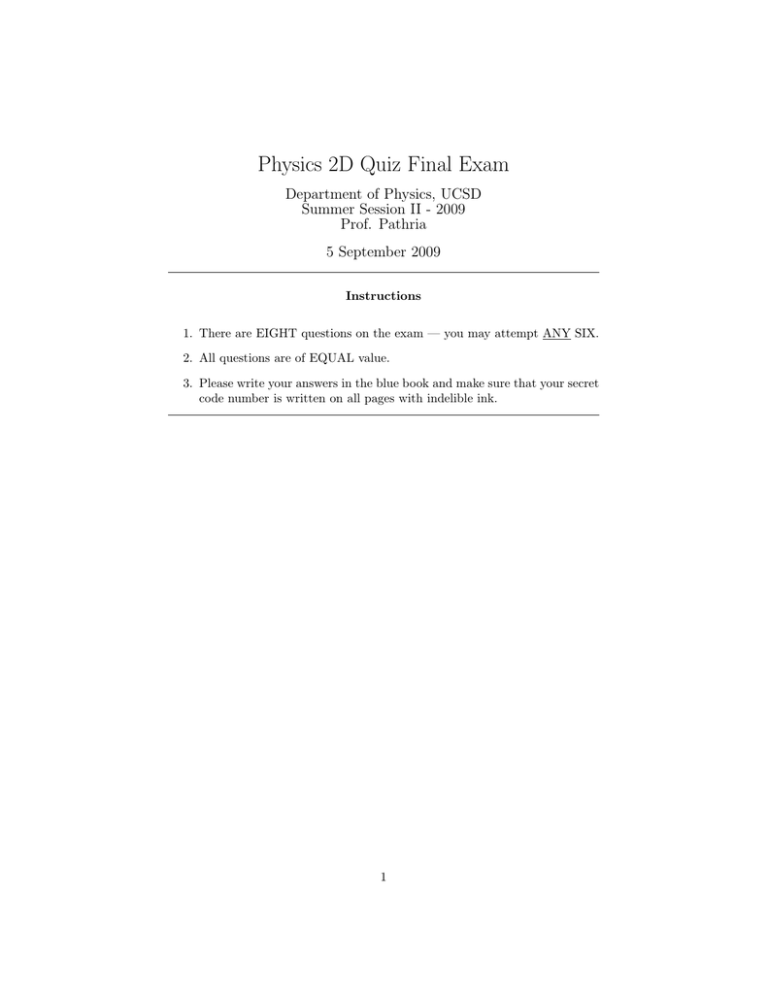
Physics 2D Quiz Final Exam Department of Physics, UCSD Summer Session II - 2009 Prof. Pathria 5 September 2009 Instructions 1. There are EIGHT questions on the exam — you may attempt ANY SIX. 2. All questions are of EQUAL value. 3. Please write your answers in the blue book and make sure that your secret code number is written on all pages with indelible ink. 1 Some Useful Numbers, Equations, and Identities Speed of light: c = 2.998×108 m/s Planck’s constant: h = 6.626×10−34 J·s h̄ = h 2π ; 1 eV = 1.602 × 10−19 J Coulomb’s constant: k = 8.99×109 Nm2 /C2 Electron Charge: e = 1.602×10−19 C Electron Mass: me = 9.11×10−31 kg = 0.511MeV/c2 Rydberg Constant: R = 1.097×107 m−1 Atomic Mass Unit: u = 1.6606×10−27 kg = 931.5 MeV/c2 Proton Mass: mp = 1.673×10−27 kg = 938.3 MeV/c2 = 1.0073 u Neutron Mass: mn = 1.675×10−27 kg = 939.6 MeV/c2 = 1.0087 u Compton wavelength for an electron: h me c Compton scattering formula: λ0 − λ0 = = 0.00243 nm h me c (1 − cosθ) Photo-electric equation: eVs = hf − φ = h (f − f0 ) Momentum for a relativistic particle: p = γm0 u, γ= q 1 2 1− vc2 Energy for a particle: E = K + mc2 = γmc2 Energy-momentum relation (particle): p = 1 c p E 2 − m20 c4 = 1 c √ 2m0 c2 K + K 2 Energy-momentum relation (photon): E = pc Relative velocity: u0 = u−v 1− uv c2 Doppler Effect (light source approaching observer): fobs = f0 De Broglie wavelength: λ = h/p 2 q 1+ vc 1− vc 2 2 h̄ d ψ Schrödinger Equation: − 2m dx2 + U (x)ψ = Eψ 1-Dimensional Normalization Condition: R∞ −∞ ψ ∗ ψdx = R∞ −∞ |ψ|2 dx = 1 Harmonic Oscillator Potential: U = 12 mω 2 x2 For a Hydrogen-like atom: 2 2 ke Z - Energy: En = − 2a 2 , 0 n n = 1, 2, 3, 4, . . . h2 4π 2 me ke2 - Bohr radius: a0 = = 0.529×10−10 m Volume element in spherical coordinates: dV = r2 sinθdrdθdφ Ground state Wavefunction for Hydrogen: Ψ (r, θ, φ) = p Root-Mean-Square deviation: ∆r = r¯2 − r̄2 Expectation Value for an operator Q: Q̄ = sin2 θ = 1 2 [1 − cos (2θ)] cos2 θ = 1 2 [1 + cos (2θ)] R∞ 2 0 R∞ 0 Rb a 1 2 pπ 2 x2 e−αx dx = α, 1 4 p all space 1 a0 dV Ψ∗ [Q]Ψ α>0 π α3 , α>0 xn e−x dx = − xn + nxn−1 + n(n − 1)xn−2 + . . . + n! e−x |ba R∞ 0 e−αx dx = R √1 π xn e−x dx = n! 3 or 3/2 4πr2 dr e−r/a0 1. Two space stations A and B are at rest relative to one another. A rocket ship is sent from A towards B at at speed of 0.6c. The captain of the rocket ship measures the time of flight from A to B as 200 seconds and sends a radio signal immediately upon passing B. (a) What is the distance between A and B as in the space stations’ frame of reference and how much time (by the space stations’ clocks) elapsed between the departure of the rocket from A and the arrival of the radio signal at A? (b) Immediately upon receiving the signal, station A sends out a second rocket, at a speed of 0.8c, to chase and finally overtake the first rocket (which is still maintaining its original speed of 0.6c relative to the space station). What is the speed of the second rocket relative to the first? (c) How much time (according to the captain of the first rocket) elapsed between his own departure from A and the meeting up of the two rockets? 2. (a) A rocket ship leaves Earth at a speed of 0.28c. It reports back to Earth by radio every hour according to its clocks. What will be the time interval between successive reports received back on Earth? (b) If the rocket ship returns a the same speed directly toward Earth and continues to report as before, what will be the new time interval between successive reports? (c) If the whole trip (outbound and inbound) lasted 48 hours according to the rocket ship’s clocks, how long did it last according to the Earth-bound clocks? 3. A neutral pion π 0 , of rest energy 135 MeV, travelling at a speed of 0.6c with respect to the laboratory frame of reference decays into two photons: π 0 −→ γ1 + γ2 (a) If the decay process causes the photons to be emitted in opposite directions along the pion’s original track, what will the energies of the photon be (in the laboratory frame of reference)? (b) If, on the other hand, the photons are emitted at equal forward angles with respect to the direction of motion of the pion, what will these angles be and what will the photon energies be? 4 4. X-ray photons with an energy of 300 keV (1 keV = 103 eV) undergo Compton scattering from a target. If a scattered photon is detected at 30 degrees relative to the incident direction, find: (a) the Compton shift at this angle, (b) the energy of the scattered photon, (c) the speed of the recoiling electron, and (d) the angle at which the electron recoils. 5. Consider a photon and an electron that have a common wavelength λ. The energy Eγ of the photon is twice the kinetic energy Ke of the electron. (a) What is the value of λ in nm? (b) What are the values of Eγ and Ke in MeV? (c) What is the speed of the electron in terms of c? 6. The nuclear potential that binds protons and neutrons inside the nucleus of an atom is often approximated by an infinite square well, i.e. U = ∞ outside the well. Imagine a proton confined in such a well of width 10−5 nm — a typical nuclear dimension. (a) If the proton undergoes a transition from the state n = 2 to the state n = 1 and in doing so emits a photon, what will the energy of the photon be, what will its wavelength be, and in what region of the spectrum will it belong? (b) In the above transition, how much momentum will the photon carry and with what velocity will the proton recoil? 5 7. (a) Write down the Schrödinger equation for a simple harmonic oscillator in one dimension. Show by substitution that the function 2 ψ(x) = Cxe−αx is a solution of this equation, provided that the constant α is chosen appropriately. What is the appropriate value of α in terms of the mass m and the angular frequency ω of the oscillator? What is the corresponding value of the energy E of the system? (b) If the oscillator, with the same energy E as found above, were treated classically, what would be the amplitude of its motion be? Call this amplitude A. (c) Go back to the quantum oscillator and determine the values of x for which the probability density P (x) of the state in question is at a maximum. Compare these values of x with the classical amplitude A. 8. For the Hydrogen atom in the ground state, calculate (a) the average distance r̄, of the electron from the nucleus, (b) the root-mean-square deviation in the value of r, (call it ∆r), and (c) the probability that the electron is found to be in the region lying between r̄ − ∆r and r̄ + ∆r. 6
